- 1College of Physics and Optoelectronics, Taiyuan University of Technology, Taiyuan, China
- 2Key Lab of Advanced Transducers and Intelligent Control System, Ministry of Education, Taiyuan University of Technology, Taiyuan, China
Introducing magnetism into the ferroelectric Ca2Nb2O7 with high Curie temperature can make it a potential multiferroic material at room temperature. Stoichiometric Ca2Nb2O7, nonstoichiometric Ca1.9Nb2O7-δ and Ca2Nb1.9O7-δ single phase films were deposited on STO (110) substrate by pulsed laser deposition under appropriate conditions. The films were characterized by XRD, FE-SEM, Element mapping and XPS. Both stoichiometric Ca2Nb2O7 and Ca1.9Nb2O7-δ films were diamagnetic in the magnetic measurement and ab initio calculations, while the Ca2Nb1.9O7-δ film with the complex vacancy of VNb+O exhibited ferromagnetic behavior at room temperature, with the saturated magnetization of 3.6 emu/cm3. Calculations on the Ca2Nb2O7 (010) surface indicate that the VNb+O can induce spin polarization on the residual O atoms around the Nb vacancies, and the system was most stable when the Nb and O vacancies were the 4th nearest-neighbored, with FM coupling energetically more stable than the AFM coupling. Our work verified experimentally and theoretically the feasibility of introducing ferromagnetism into Ca2Nb2O7 film by the intrinsic complex vacancy of VNb+O.
Introduction
Multiferroic materials with the co-existance of ferroelectricity (FE) and ferromagnetism (FM) have received considerable attention in recent years due to the unique physical mechanism of magnetoelectric coupling and potential applications in the fields of information storage, processing and sensing (Fiebig, 2005; Chun et al., 2012). However, the natural conflict between FM and FE leads to the rarity of multiferroic material at room temperature (RT) (Hill, 2000). Ca2Nb2O7 is a member of the AnNbnO3n+2 family with n = 4, which has layered perovskite structure and high ferroelectric Curie temperature (above 1850°C) (Lichtenberg et al., 2001). The introduction of FM into ferroelectric Ca2Nb2O7 could make it a potential multiferroic material at RT.
In order to achieve FM in ferroelectric materials, doping magnetic elements was the most frequently adopted method. So far, RTFM has been experimentally observed in the Fe-doped BaTiO3 films (Ramana et al., 2013; Chand Verma et al., 2014), Fe-doped LiTaO3 ceramics (Song et al., 2014) and Fe-doped K0.45Na0.49Li0.06NbO3 ceramics (Liu et al., 2015), the origin of which can be theoretically well explained by the F-center model for diluted magnetic semiconductors. Besides, nonmagnetic element doping induced d0 magnetism has been observed in BaTiO3 film/ceramics, Nb-doped BaTiO3 film and LiNbO3 nanocrystallites, the origin of which was ascribed to the oxygen vacancy (Mangalam et al., 2009; Yang et al., 2010; Díaz-Moreno et al., 2014). However, the observed FM in Eu-doped CdNb2O6 powders was elucidated with the intrinsic exchange interactions between the magnetic moments associated with the unpaired 4f electrons in Eu3+ ions (Topkaya et al., 2017). The RTFM in K0.5Na0.5NbO3 PLD film was related to the cationic K and Na vacancies (Cao et al., 2011a), while the RTFM observed in BaNb2O6 film was contributed mainly by the oxygen vacancy, with certain contribution by the Nb vacancy (Cao et al., 2012). In the aspect of theoretical study, both Ti and O vacancies were found to be able to induce FM in BaTiO3 bulk material and (001) surface (Cao et al., 2009; Cao et al., 2011b) and in PbTiO3 (Shimada et al., 2012). However, O vacancy was found to be able to induce FM in LiNbO3 but cannot induce FM in LiTaO3 and Sr2AlNbO6 (Cao et al., 2013; Li et al., 2014).
Therefore, the origin of FM in undoped ferroelectric material is still controversial in both experimental and theoretical results. Meanwhile, most of the analyses on the vacancy-induced d0 magnetism in ferroelectric oxide films just considered various cation vacancies or oxygen vacancy alone, the synergistic effect of cation and oxygen vacancies, i.e., the effect of complex vacancy, was seldom studied. Herein, the advantage of the identical composition between the film and ceramic target in pulsed laser deposition (PLD) was utilized to prepare stoichiometric Ca2Nb2O7 single phase film and those with the complex vacancy of VCa+O or VNb+O by varying the composition of Ca2Nb2O7 ceramic targets. The probability of achieving d0 magnetism in the nonstoichiometric Ca2Nb2O7 single phase film by complex vacancy was comprehensively examined by magnetic measurement and ab initio calculations.
Materials and Methods
CaCO3 and Nb2O5 were used as raw material and weighted according to the atomic ratio of Ca/Nb as 0.95/1, 1/1, and 1/0.95, respectively. Stoichiometric and nonstoichiometric Ca2Nb2O7 ceramic targets with intrinsic cation vacancies were then obtained by the conventional solid state reaction. Ablation of the targets were achieved using a KrF excimer laser source (λ = 248 nm, pulse duration = 20 ns, energy of pulse = 200 mJ, frequency of pulse = 3 Hz). SrTiO3 (110) substrate in the size of 5 mm × 5 mm was chosen due to its smaller lattice mismatch with the Ca2Nb2O7 lattice. The deposition duration was 0.5 h, the distance between the target and substrate was 60 mm, the substrate temperature (TS) was 650°C, and the oxygen pressure (PO) was 1 mTorr for all depositions.
The crystal structure was examined by High Resolution X-ray Diffractometer (D8 discover, Bruker AXS GmbH, German) using Cu Kα radiation. The SEM and element mapping on the surface were performed by Scanning Electron Microscope (SU8010, Hitachi, Japan). X-ray photoelectron spectra were obtained by X-ray Photoelectron Spectrometer with monochromated Al Kα radiation (Escalab 250, Thermo Electron Corporation, United States). Magnetic properties were measured by Magnetic Property Measurement System (MPMS-5XL, Quantum design, United States) with magnetic field parallel to the surface of film. The film thickness was checked by Stylus Surface Profiler (Dektak 150, Veeco Metrology, France).
Results and Discussion
Structural and Surface Characterizations
Figure 1 shows the XRD patterns of the STO substrate and the as-deposited films. Aside from the (110) and (220) diffraction peaks from the substrate (see Figure 1A), the only appearance of (040) diffraction peaks from orthorhombic Ca2Nb2O7 (PDF#70-2006) in Figure 1B means that single phase of stoichiometric Ca2Nb2O7 was obtained under the current deposition conditions without impurity phase. The Ca2Nb2O7 (020) diffraction peaks in Figures 1C,D indicated that the single phase of Ca2Nb2O7 was maintained using the targets with 5% Ca or Nb deficiency. To maintain the charge neutrality, the Ca or Nb vacancy would lead to the concomitant appearance of oxygen vacancy in the Ca2Nb2O7 lattice, therefore, the nonstoichiometric Ca2Nb2O7 films were denoted as Ca1.9Nb2O7-δ and Ca2Nb1.9O7-δ, respectively. The film thickness of the three samples was close and approximated to be 100 nm. The SEM images for the Ca2Nb2O7, Ca1.9Nb2O7-δ and Ca2Nb1.9O7-δ surfaces are displayed in the Supplementary Figure S1. Smooth and even surface could be observed for the Ca2Nb2O7 film, while bumps and hollows were present on the surface of nonstoichiometric films, with the highest degree of roughness obtained by the Ca2Nb1.9O7-δ surface. The corresponding element mapping images show that the elements Ca and Nb from the Ca2Nb2O7 films were uniformly distributed on the surface of STO substrate for all samples, while the element O exhibited higher degree of density due to the simultaneous contribution from the film and substrate.
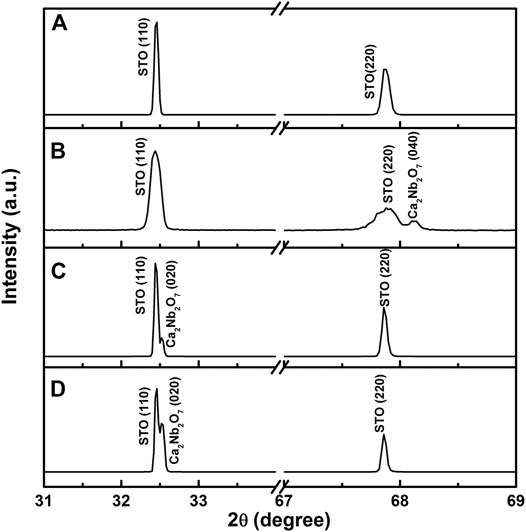
FIGURE 1. XRD patterns of the STO substrate (A), the as-deposited films using stoichiometric Ca2Nb2O7 target (B), nonstoichiometric Ca2Nb2O7 target with 5% Ca deficiency (C) and Nb deficiency (D).
Figure 2 shows the core level XPS for the Ca2Nb2O7, Ca1.9Nb2O7-δ and Ca2Nb1.9O7-δ films. All spectra were charge corrected according to the C-C peak at the binding energy (BE) of 284.8 eV. In Figure 2A, the C-C and C-O-C peaks come from the adventitious carbon contamination, while the small amount of O-C=O peaks originate from the carbonate formed on the surface. From the Ca 2p and Nb 3d XPS in Figures 2B,C, Ca and Nb ions were in the valence states of +2 and +5 respectively. Since there is no other valence states present for Ca and Nb, the existence of Ca or Nb vacancy in the Ca2Nb2O7 lattice can only induce oxygen vacancies to maintain the charge neutrality, hence the complex vacancy of VCa+O and VNb+O should be present in Ca1.9Nb2O7-δ and Ca2Nb1.9O7-δ films, respectively. With respect to the stoichiometric Ca2Nb2O7 film, the Ca1.9Nb2O7-δ film exhibited 0.17 eV lower BE for the Ca 2p3/2 peak but 0.51 eV higher BE for the Nb 3d5/2 peak, while the Ca2Nb1.9O7-δ film exhibited 0.63 eV lower BE for the Ca 2p3/2 peak but 0.05 eV lower BE for the Nb 3d5/2 peaks. As for the O 1s XPS, lattice oxygen (OL) and adsorbed oxygen (Oads) were present in all samples, but the relative content of Oads for the Ca2Nb1.9O7-δ film was 58.8% which was much higher the 40.53 and 40.01% for the Ca2Nb2O7 and Ca1.9Nb2O7-δ films, respectively.
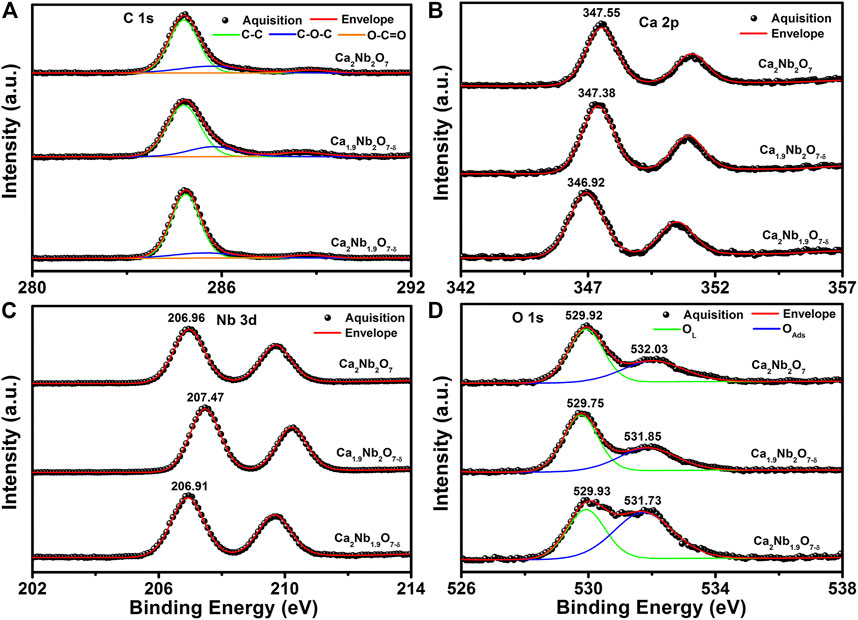
FIGURE 2. C 1s (A), Ca 2p (B), Nb 3d (C) and O 1s (D) core level XPS for the Ca2Nb2O7, Ca1.9Nb2O7-δ and Ca2Nb1.9O7-δ films.
Magnetic Measurement
Figure 3 displays the MH curves for the STO substrate, Ca2Nb2O7, Ca1.9Nb2O7-δ and Ca2Nb1.9O7-δ films on STO measured at room temperature. Compared with the diamagnetic behavior of the STO substrate, the stronger diamagnetic signals in the Ca2Nb2O7 and Ca1.9Nb2O7-δ films on STO suggest the presence of diamagnetism in the obtained films. However, the Ca2Nb1.9O7-δ film on STO showed much weaker diamagnetic signal. As shown in Figure 3B, MH hysteresis loop was observed for the Ca2Nb1.9O7-δ film after subtraction of the diamagnetic signal from the substrate, meaning that the Ca2Nb1.9O7-δ film exhibited weak ferromagnetic behavior. Given the film thickness of 100 nm, the saturated magnetic moment of 9×10−6 emu corresponds to the magnetization of 3.6 emu/g for the Ca2Nb1.9O7-δ film.
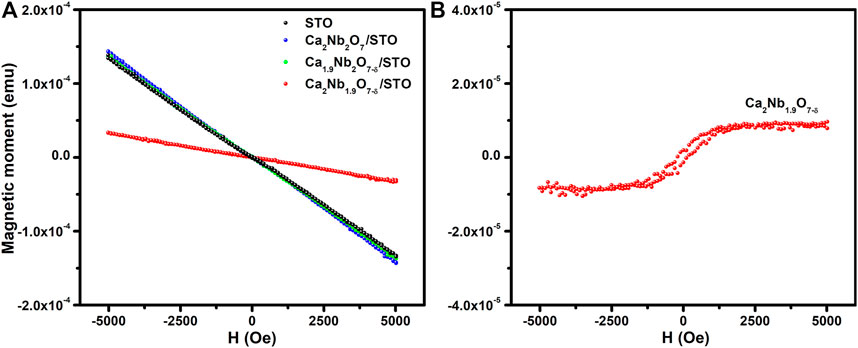
FIGURE 3. Original MH curves for the STO substrate, Ca2Nb2O7, Ca1.9Nb2O7-δ and Ca2Nb1.9O7-δ films on STO measured at room temperature (A), and the MH curve for the Ca2Nb1.9O7-δ film after subtraction of the diamagnetic signal from the substrate (B).
Theoretical Calculation
In order to explore the origin of FM in the Ca2Nb1.9O7-δ film, the density functional theory (DFT) calculations were performed using the plane-wave pseudopotential method in the Vienna Ab initio Simulation Package (VASP) (Kresse and Hafner, 1993a; Kresse and Joubert, 1999). The Projector Augmented Wave (PAW) (Kresse and Hafner, 1993b; Blöchl, 1994) potentials were employed, and General Gradient Approximate (GGA) was used to describe the exchange correlation energy. According to the XRD result, an orthorhombic Ca2Nb2O7 1 × 2 × 1 supercell containing 176 atoms was first relaxed to get the most stable structure (see Supplementary Figure S2A) until the total energy in the optimized structure was converged to 1.0 × 10−4 eV/atom and the Hellman-Feynman force was smaller than 0.01 eV/Å. Then four different (010) planes were cleaved along the b axis, and a 10Å vacuum layer which was thick enough to isolate the atom layers was added above the supercell for further optimization. Among the four (010) surfaces, the configuration in the Supplementary Figure S2B showed the lowest energy, on which further calculations were performed.
The stable configuration of Ca2Nb2O7 (010) surface with labeled Ca, Nb, and O atoms to be removed for vacancy study is displayed in Figure 4A, among which O1 is connected only to one Nb atom, O2 is coordinated between two neighbored Nb atoms, O3 connects one Nb atom in the outermost layer with another Nb atom in the second layer, while O4 denote the one between two Nb atoms in the second layer. Stoichiometric Ca2Nb2O7 (010) surface was firstly studied and the total DOS was showed in Figure 4B. No spin polarization could be observed around the Fermi level, meaning that the stoichiometric Ca2Nb2O7 (010) surface is nonmagnetic.
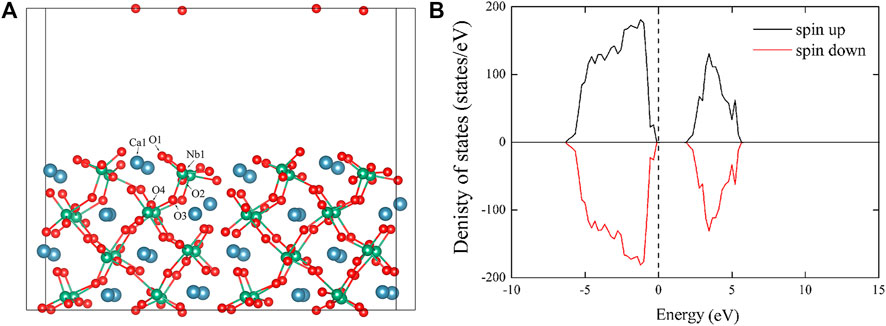
FIGURE 4. Stable configuration of Ca2Nb2O7 (010) surface with labeled Ca, Nb and O atoms to be removed for vacancy study (A), and the total DOS of stoichiometric Ca2Nb2O7 (010) surface (B).
The complex vacancy of VCa+O in four different distributions, i.e., Ca1+O1, Ca1+O2, Ca1+O3, and Ca1+O4, was then studied. The relative stability (ΔE) of the Ca2Nb2O7 (010) surface with these four types of complex vacancy was 3.51, 4.18, 0, and 2.21 eV respectively, meaning that the system with VCa1+O3 was most stable. However, no spin polarization could be observed in the DOSs around the Fermi level in Figure 5, indicating that the complex vacancy of VCa+O cannot induce magnetism in the Ca2Nb2O7 (010) surface. On the other side, the complex vacancy of VNb+O in four different distributions all induced spin polarization around the Fermi level and impurity bands in the forbidden gap (see Figure 6), which were contributed mainly by the O 2p electrons. The three-dimensional iso-surfaces of magnetization density in the inset of Figure 6 show that the complex vacancies of VNb+O mainly induced spin polarization on the residual O atoms around the Nb vacancies. The total net magnetic moment (Mtot) of the system with VNb1+O1, VNb1+O2, VNb1+O3, and VNb1+O4 was 1.0, 0.99, 0.96, and 1.0 μB, respectively. Among which, the system with VNb1+O4 was the most stable one with the lowest energy, and the ΔE of the system with VNb1+O1, VNb1+O2 and VNb1+O3 was 1.04, 27.46, and 27.90 eV, respectively. More importantly, FM coupling was energetically more favorable than AFM coupling in the cases of VNb1+O1 and VNb1+O4, with the relative energy between FM and AFM as 7 and 45 meV, respectively.
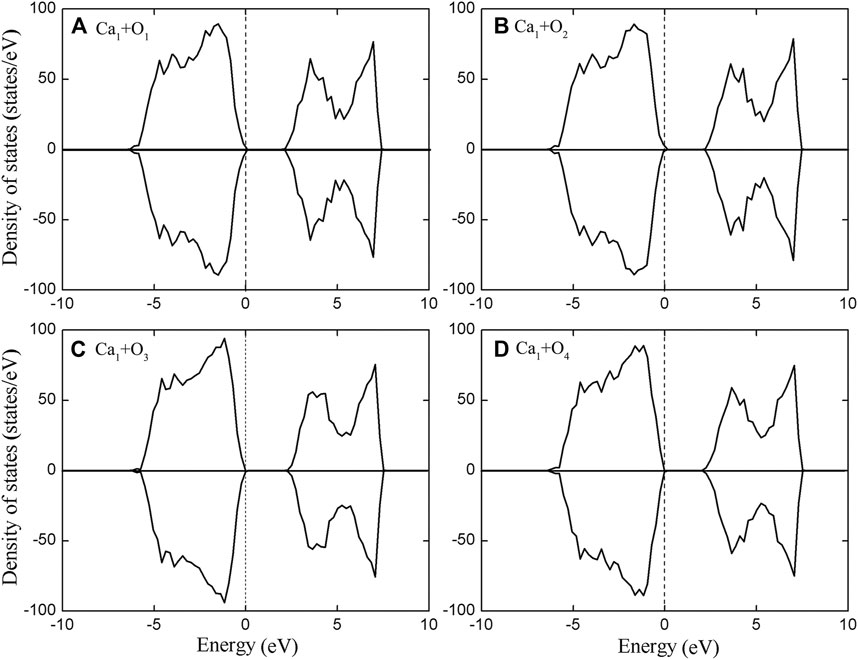
FIGURE 5. DOSs of Ca2Nb2O7 (010) surface with the complex vacancy of VCa+O in the distributions of Ca1+O1(A), Ca1+O2(B), Ca1+O3(C), and Ca1+O4(D).
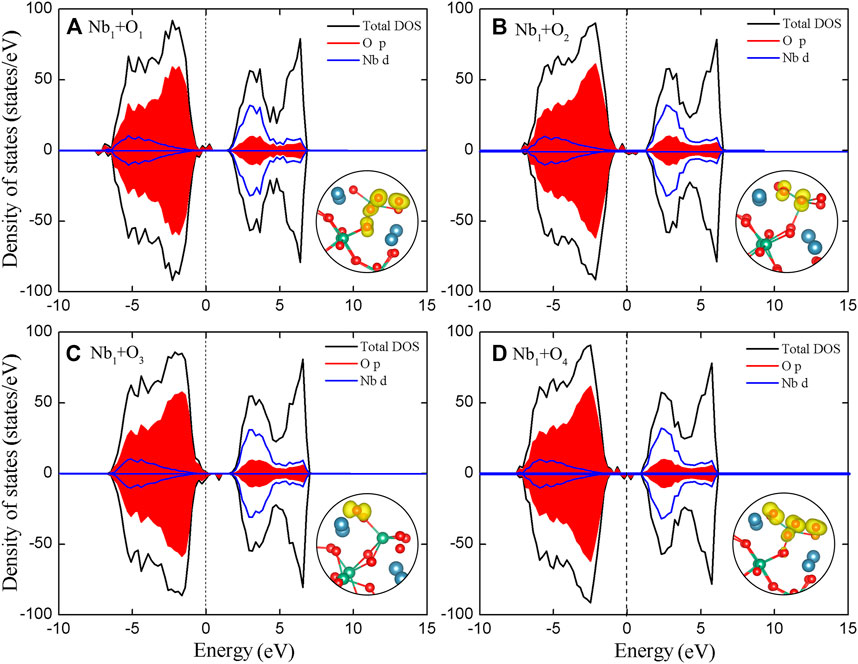
FIGURE 6. Total and partial DOSs of Ca2Nb2O7 (010) surface with the complex vacancy of VNb+O in the distributions of Nb1+O1(A), Nb1+O2(B), Nb1+O3(C), and Nb1+O4(D). The insets show the corresponding three-dimensional iso-surfaces of magnetization density.
Conclusion
Nonstoichiometric Ca2Nb2O7 single phase films with the complex vacancy of VCa+O or VNb+O were deposited on STO (110) substrate under appropriate deposition conditions using nonstoichiometric ceramic targets. The VCa+O cannot induce magnetism in the diamagnetic stoichiometric Ca2Nb2O7 (020) single phase film, while VNb+O can induce spin polarization on the residual O atoms around the Nb vacancies, and make the Ca2Nb2O7 film exhibit FM behavior at RT. Our work demonstrated experimentally and theoretically that the introduction of intrinsic complex vacancy during deposition should be a feasible way to induce ferromagnetism in the ferroelectric Ca2Nb2O7 film, and this method might be applicable to other A2Nb2O7-type niobate ferroelectric films as well.
Data Availability Statement
The original contributions presented in the study are included in the article/Supplementary Material, further inquiries can be directed to the corresponding author.
Author Contributions
EC contributed to conception and design of the study. LW, YZ and ZN contributed to the acquisition, analysis and interpretation of data. All authors contributed to manuscript revision, read, and approved the submitted version.
Funding
This work was supported by National Natural Science Foundation of China (11404236, 11604236, and 11974258), Natural Science Foundation of Shanxi Province (201901D111117 and 201901D111126).
Conflict of Interest
The authors declare that the research was conducted in the absence of any commercial or financial relationships that could be construed as a potential conflict of interest.
The handling Editor declared a past co-authorship with one of the authors NZ.
Publisher’s Note
All claims expressed in this article are solely those of the authors and do not necessarily represent those of their affiliated organizations, or those of the publisher, the editors and the reviewers. Any product that may be evaluated in this article, or claim that may be made by its manufacturer, is not guaranteed or endorsed by the publisher.
Acknowledgments
Part of this study has been performed using facilities at IBS Center for Correlated Electron Systems, Seoul National University.
Supplementary Material
The Supplementary Material for this article can be found online at: https://www.frontiersin.org/articles/10.3389/fmats.2021.736011/full#supplementary-material
References
Blöchl, P. E. (1994). Projector Augmented-Wave Method. Phys. Rev. B 50, 17953–17979. doi:10.1103/physrevb.50.17953
Cao, D., Cai, M.-Q., Hu, W.-Y., Yu, P., and Huang, H.-T. (2011). Vacancy-induced Magnetism in BaTiO3(001) Thin Films Based on Density Functional Theory. Phys. Chem. Chem. Phys. 13, 4738–4745. doi:10.1039/c0cp02424d
Cao, D., Cai, M. Q., Zheng, Y., and Hu, W. Y. (2009). First-principles Study for Vacancy-Induced Magnetism in Nonmagnetic Ferroelectric BaTiO3. Phys. Chem. Chem. Phys. 11, 10934–10938. doi:10.1039/b908058a
Cao, E., Hu, J., Qin, H., Ji, F., Zhao, M., and Jiang, M. (2011). Room Temperature Ferromagnetism and Magnetoelectric Coupling in (K0.5Na0.5)NbO3 PLD Nanocrystalline Films. J. Alloys Comp. 509, 2914–2918. doi:10.1016/j.jallcom.2010.11.155
Cao, E., Zhang, Y., Ju, L., Sun, L., Qin, H., and Hu, J. (2012). The Investigation of Room Temperature Ferromagnetism in (100) Oriented BaNb2O6 PLD Films on LaAlO3 (100) Substrate. Appl. Surf. Sci. 258, 3795–3799. doi:10.1016/j.apsusc.2011.12.031
Cao, E., Zhang, Y., Qin, H., Zhang, L., and Hu, J. (2013). Vacancy-induced Magnetism in Ferroelectric LiNbO3 and LiTaO3. Physica. B. Condens. Matter 410, 68–73. doi:10.1016/j.physb.2012.10.030
Chand Verma, K., Kaur, J., Negi, N. S., and Kotnala, R. K. (2014). Multiferroic and Magnetoelectric Properties of Nanostructured BaFe0.01Ti0.99O3 Thin Films Obtained under Polyethylene Glycol Conditions. Solid State. Commun. 178, 11–15. doi:10.1016/j.ssc.2013.10.020
Chun, S. H., Chai, Y. S., Jeon, B. G., Kim, H. J., Oh, Y. S., Kim, I., et al. (2012). Electric Field Control of Nonvolatile Four-State Magnetization at Room Temperature. Phys. Rev. Lett. 108, 177201. doi:10.1103/physrevlett.108.177201
Díaz-Moreno, C. A., Farías-Mancilla, R., Matutes-Aquino, J. A., Elizalde-Galindo, J., Espinosa-Magaña, F., González-Hernández, J., et al. (2014). Magnetic Behavior in LiNbO3 Nanocrystallites Caused by Oxygen Vacancies. J. Magnetism Magn. Mater. 356, 82–86. doi:10.1016/j.jmmm.2013.12.029
Fiebig, M. (2005). Revival of the Magnetoelectric Effect. J. Phys. D. Appl. Phys. 38, R123–R152. doi:10.1088/0022-3727/38/8/r01
Hill, N. A. (2000). Why Are There So Few Magnetic Ferroelectrics? J. Phys. Chem. B 104, 6694–6709. doi:10.1021/jp000114x
Kresse, G., and Hafner, J. (1993). Ab Initiomolecular Dynamics for Liquid Metals. Phys. Rev. B 47, 558–561. doi:10.1103/physrevb.47.558
Kresse, G., and Hafner, J. (1993). Ab Initiomolecular Dynamics for Open-Shell Transition Metals. Phys. Rev. B 48, 13115–13118. doi:10.1103/physrevb.48.13115
Kresse, G., and Joubert, D. (1999). From Ultrasoft Pseudopotentials to the Projector Augmented-Wave Method. Phys. Rev. B 59, 1758–1775. doi:10.1103/physrevb.59.1758
Li, Y. D., Wang, C. C., Cheng, R. L., Lu, Q. L., Huang, S. G., and Liu, C. S. (2014). Vacancy-driven Magnetism in Nonmagnetic Double Perovskite Sr2AlNbO6: A First-Principles Study. J. Alloys Comp. 598, 1–5. doi:10.1016/j.jallcom.2014.01.176
Lichtenberg, F., Herrnberger, A., Wiedenmann, K., and Mannhart, J. (2001). Synthesis of Perovskite-Related Layered AnBnO3n+2 = ABOX Type Niobates and Titanates and Study of Their Structural, Electric and Magnetic Properties. Prog. Solid State. Chem. 29, 1–70. doi:10.1016/s0079-6786(01)00002-4
Liu, L., Shi, D., Fan, L., Chen, J., Li, G., Fang, L., et al. (2015). Ferroic Properties of Fe-Doped and Cu-Doped K0.45Na0.49Li0.06NbO3 Ceramics. J. Mater. Sci. Mater. Electron. 26, 6592–6598. doi:10.1007/s10854-015-3257-z
Mangalam, R. V. K., Ray, N., Waghmare, U. V., Sundaresan, A., and Rao, C. N. R. (2009). Multiferroic Properties of Nanocrystalline BaTiO3. Solid State. Commun. 149, 1–5. doi:10.1016/j.ssc.2008.10.023
Ramana, E. V., Yang, S. M., Jung, R., Jung, M. H., Lee, B. W., and Jung, C. U. (2013). Ferroelectric and Magnetic Properties of Fe-Doped BaTiO3 Thin Films Grown by the Pulsed Laser Deposition. J. Appl. Phys. 113, 187219. doi:10.1063/1.4801965
Shimada, T., Uratani, Y., and Kitamura, T. (2012). Vacancy-driven Ferromagnetism in Ferroelectric PbTiO3. Appl. Phys. Lett. 100, 162901. doi:10.1063/1.4704362
Song, Y.-J., Zhang, Q.-H., Shen, X., Ni, X.-D., Yao, Y., and Yu, R.-C. (2014). Room-Temperature Magnetism Realized by Doping Fe into Ferroelectric LiTaO3. Chin. Phys. Lett. 31, 017501. doi:10.1088/0256-307x/31/1/017501
Topkaya, R., Boyraz, C., and Ekmekçi, M. K. (2017). Structural and Magnetic Properties of Eu3+-Doped CdNb2O6 Powders. J. Low Temp. Phys. 190, 244–255. doi:10.1007/s10909-017-1835-6
Keywords: PLD, ab initio calculation, complex vacancy, Ca2Nb2O7, d0 magnetism
Citation: Wu L, Zhang Y, Nie Z and Cao E (2021) Intrinsic Complex Vacancy-Induced d0 Magnetism in Ca2Nb2O7 PLD Film. Front. Mater. 8:736011. doi: 10.3389/fmats.2021.736011
Received: 04 July 2021; Accepted: 22 July 2021;
Published: 05 August 2021.
Edited by:
Han Lin, Swinburne University of Technology, AustraliaReviewed by:
Tongshuai Xu, Anyang Normal University, ChinaFeng Jiang, Dalian University of Technology, China
Copyright © 2021 Wu, Zhang, Nie and Cao. This is an open-access article distributed under the terms of the Creative Commons Attribution License (CC BY). The use, distribution or reproduction in other forums is permitted, provided the original author(s) and the copyright owner(s) are credited and that the original publication in this journal is cited, in accordance with accepted academic practice. No use, distribution or reproduction is permitted which does not comply with these terms.
*Correspondence: Ensi Cao, ECao@163.com
 Linjie Wu
Linjie Wu Yongjia Zhang1
Yongjia Zhang1 Ensi Cao
Ensi Cao